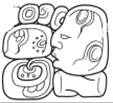![]()
![]()
![]()
K&L.p26.#2 = 25EMC.pdfp52 TOK.p20.r1.c2 BMM9.p16.r4.c3
YUK YUK YUK? YUK?
· No glyphs given in K&H.
· EB.p212.pdfp217.#6: yuk- pv. “to shake”:
o EB provides only two references, both with syllabogram spellings yu-ku-[…]. All instances of the CLK rulers with the name Yuknoom are all also given with syllabogram spellings for Yuk-, so none of those names write it with YUK.
o EB marks this as a positional verb. One might be tempted to wonder if this is a typo, but baj- “to hammer”, em- “to descend”, jop- “to fill”, k’al- “to bind”, pan- “to dig”, pitz- “to play ball”, are all marked as pv. also (in addition to the expected chum- “to sit”, pak- “to turn over”, pat- “to shape, to form”, wa- “to put upright”).
· Esparza-TYLiMHW is the paper which proposes this reading. Esparza-AaESiPB.p10.col1.para2-para3 also pre-empts this.
· Sources are divided on whether the reading is made with confidence or with some doubt.


Zender-BH.p10.fig8.a Zender-BH.p10.fig8.v
PAL T.XVIII stuccos K3636 unprovenanced
<yu:ku[la]ja>.<KAB:nu> yu ku:la{j} CHAN.na K’AWIIL:la
· The two examples given appear to relate to “shaking” the earth or the sky: yuklaj kab / yuklaj chan.